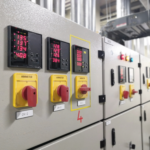Battery room hazards include; electrical, chemical, fire, respiratory, ergonomic, and sheer weight of the battery jars. Addressing each of these concerns is critical to battery room safety. In-house maintenance personnel, AC electricians and fly-by-night battery installers often do not have the training, experience, and correct tools to work with these systems according to published battery room safety standards. It is for this reason that using a professional company that specializes in industrial battery installation, removal, and maintenance is the safest choice for this specialized work.
Battery safety standards that cover working safe in battery rooms include;
- 29 CFR 1910.331-335 – Electrical Safety Related Work Practices
This standard covers basic OSHA safety requirements for employees who work on or near electrical systems. It addresses training, live work, lockout, approach distances, equipment requirements, grounding, protective insulation, signage, barricades, etc… It is however not battery specific.
- 29 CFR 1910.305(j)(7) – Wiring Methods, Components, and Equipment
This standard for general industry addresses battery ventilation to prevent explosion.
- 29 CFR 1926.441 – Batteries and Battery Charging
This standard for construction addresses battery ventilation, racking, battery room floors, PPE, safety eye wash location distances, safety shower location distances, and battery charging safety requirements.
- NFPA 70E Article 320 – Electrical Safety in the Workplace (Safety Requirements Related to Batteries and Battery Rooms)
This article from NFPA 70E Electrical Safety in the Workplace covers electrical safety requirements for the practical safeguarding of employees while working with exposed stationary storage batteries that exceed 50 volts, nominal. It addresses battery safety signage, apparel, PPE, Illumination, access to energized batteries, electrolyte precautions, strategies to mitigate battery electrical hazards, direct current ground fault detection, tool requirements for working on batteries, as well as fire concerns.
- NFPA 70E 205 – General Maintenance Requirements
This article from NFPA 70E Electrical Safety in the Workplace covers battery maintenance safety requirements including issues of qualified persons, circuit identification, overcurrent protective devices, working space requirements around battery systems, and battery wiring requirements.
- NFPA 70 Article 480 – National Electric Code (Storage Batteries)
This article from NFPA 70 National Electric Code covers installation and wiring requirements for battery electrical systems. Correct installation and wiring are critical to the safety of those working on or near these systems.
- IEEE Std. 450 – Recommended Practice for Maintenance, Testing, and Replacement of Vented Lead-Acid Batteries for Stationary Applications
- IEEE Std. 1106 – Recommended Practice for Installation, Maintenance, Testing, and Replacement of Vented nickel-Cadmium Batteries for Stationary Applications
- IEEE Std. 1188 – Recommended Practice for Maintenance, Testing, and Replacement of Valve Regulated Lead-Acid Batteries (VRLA) for Stationary Applications
- IEEE Std. 1657 – Recommended Practice for Personnel Qualifications for Installation and Maintenance of Stationary Batteries
Disclaimer: The references above are just some of the standards that apply to battery work and battery rooms. Employers should do their own research to ensure they are following all federal, state, and local regulations and codes, or hire a safety professional to make these determinations as they apply to the specific circumstances.





